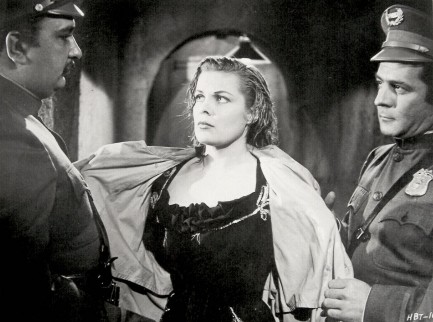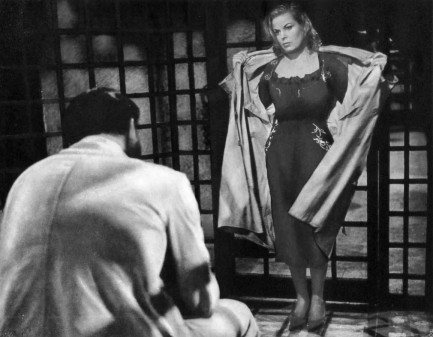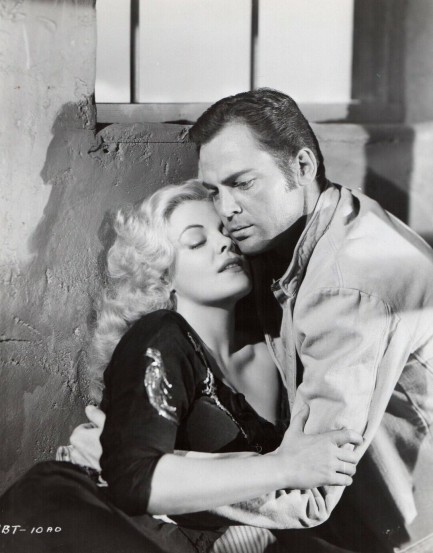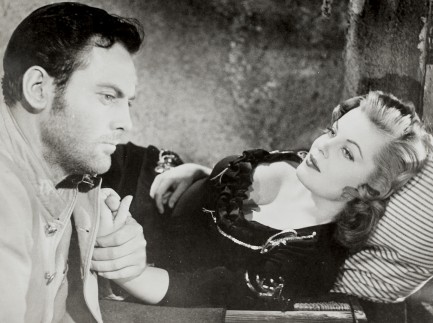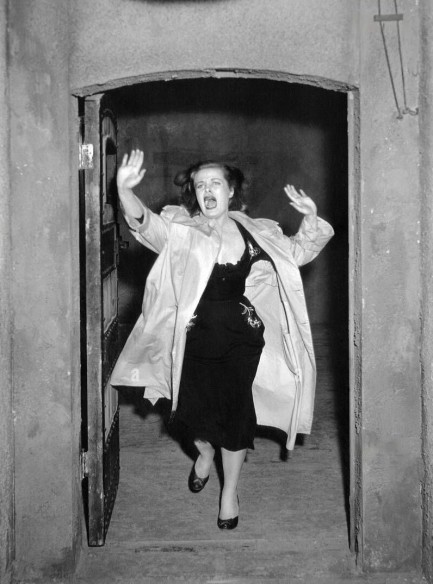 Strange ideas from the minds and lenses of mid-century promo photographers. 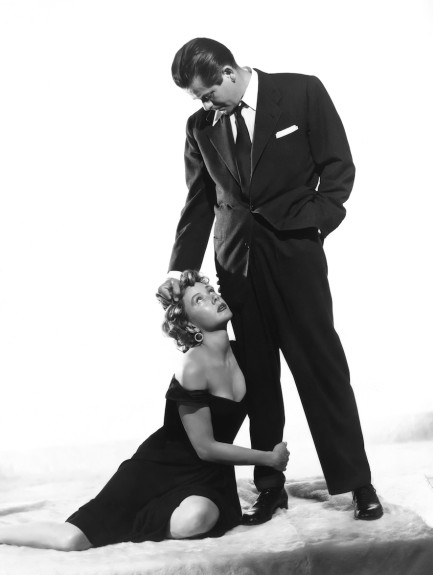 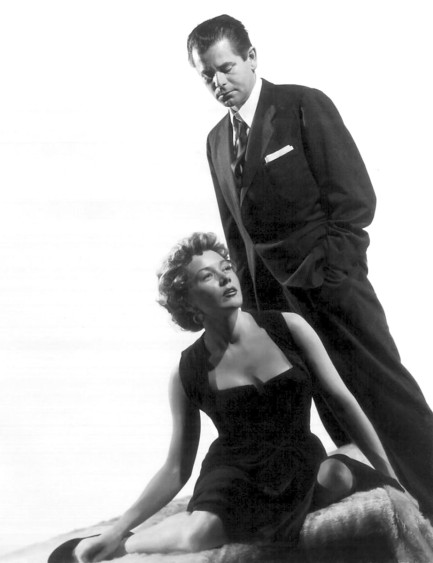 A while back we shared a promo photo of Glenn Ford and Gloria Grahame from 1953's The Big Heat that was meant to imply oral sex (it absolutely was, and you can see for yourself here). We commented on its weirdness, and noted that an actress would probably not be asked or made to pose that way today. The shot got us thinking about whether there were other kneeling promo shots from the mid-century era, and above you see two others from The Big Heat. Below we have more such shots, and while none are as jarring as that previous promo, they're all interesting. We assumed there would be few if any featuring kneeling males, but we found a couple. Even so, there are probably scores more kneeling actresses that we missed. While many of shots took the form they did to highlight the criminal/victim themes in their parent films, you still have to wonder what else—consciously or not—was in the various photograhers' minds. Anyway, just some food for thought this lovely Thursday. Ready, set discuss! 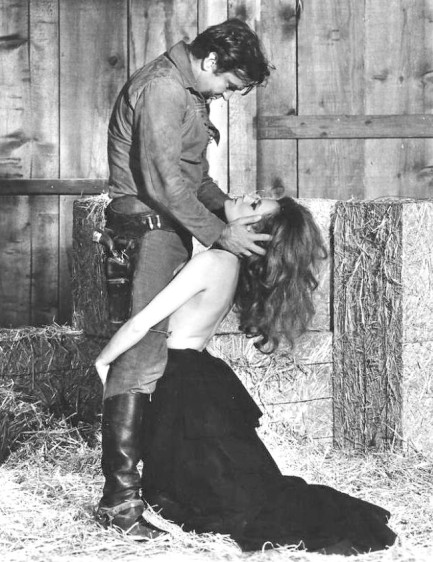 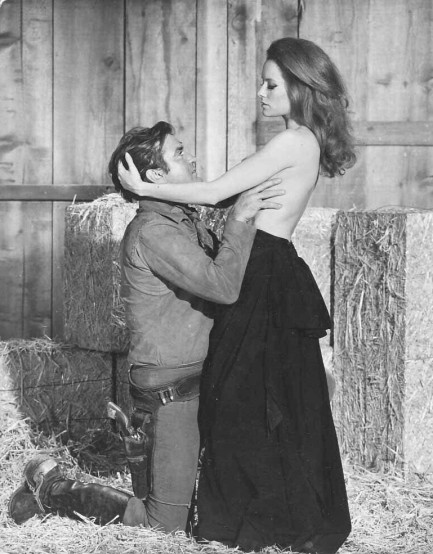 Rod Taylor and Luciana Pauluzzi swap subordinate positions for 1967's Chuka. Rod Taylor and Luciana Pauluzzi swap subordinate positions for 1967's Chuka.
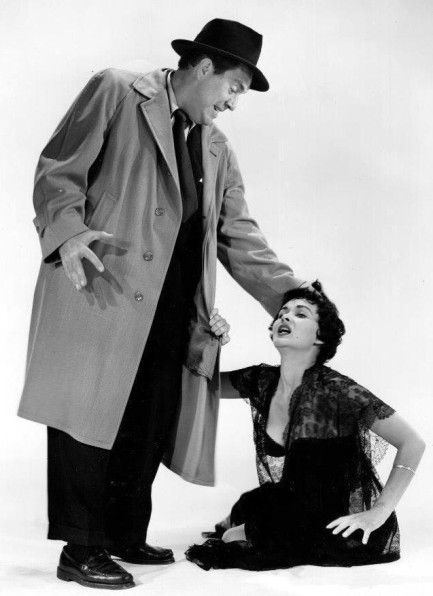 Edmund O'Brien goes for the time honored hair grab on Marla English for 1954's Shield for Murder. Edmund O'Brien goes for the time honored hair grab on Marla English for 1954's Shield for Murder.
 Inger Stevens and Terry Ann Ross for Cry Terror, an adaptation of a novel we talked about a few years ago. Inger Stevens and Terry Ann Ross for Cry Terror, an adaptation of a novel we talked about a few years ago.
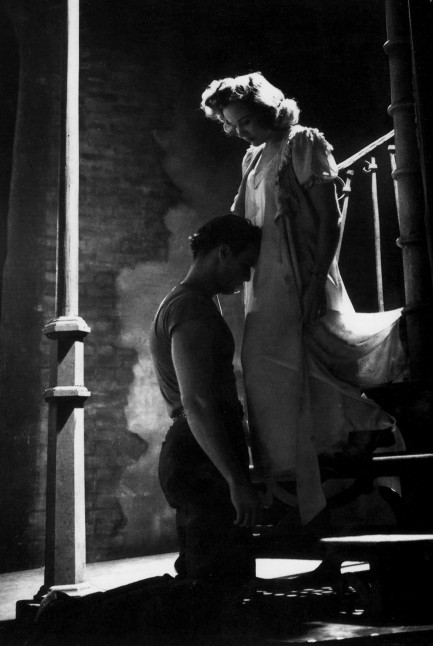 Kim Hunter soothes an overheated Marlon Brando in a promo for 1951's A Streetcar Named Desire. Kim Hunter soothes an overheated Marlon Brando in a promo for 1951's A Streetcar Named Desire.
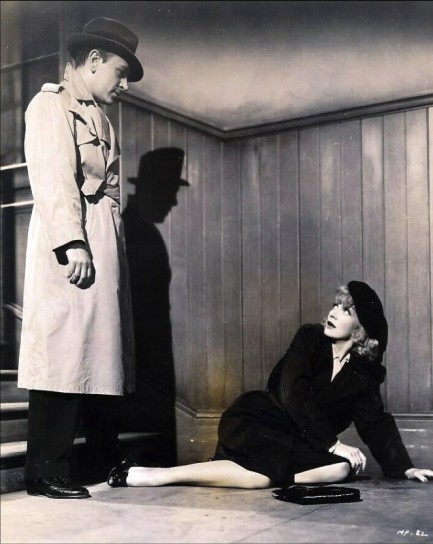 George Raft menaces Marlene Dietrich in the 1941 comedy Manpower. George Raft menaces Marlene Dietrich in the 1941 comedy Manpower.
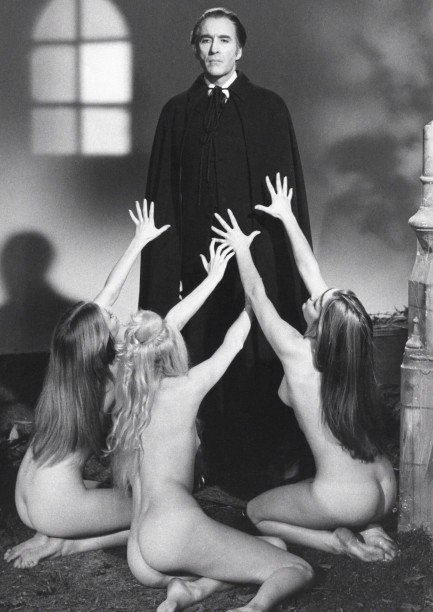 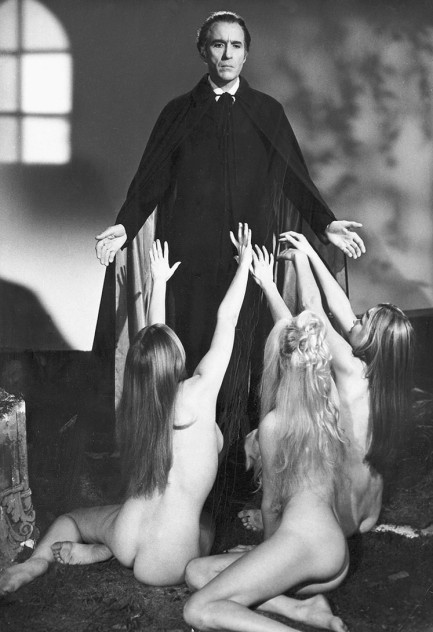 As promos go, these actually make sense. They show three unidentified models mesmerized by vampire Christopher Lee for 1970's Taste the Blood of Dracula. As promos go, these actually make sense. They show three unidentified models mesmerized by vampire Christopher Lee for 1970's Taste the Blood of Dracula.
 Glenn Ford is at it again, this time looming over Rita Hayworth for the 1946 classic Gilda. Glenn Ford is at it again, this time looming over Rita Hayworth for the 1946 classic Gilda. 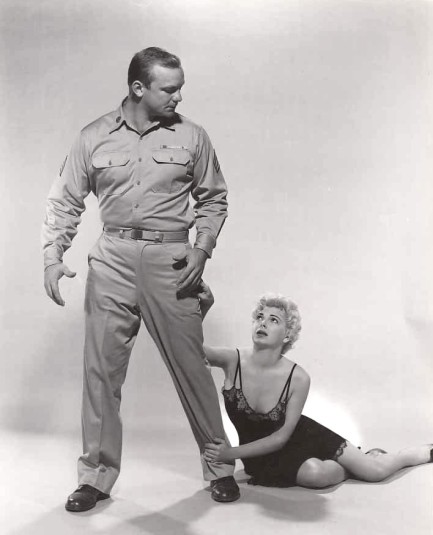 Aldo Ray and Barbara Nichols for 1958's The Naked and the Dead. Aldo Ray and Barbara Nichols for 1958's The Naked and the Dead.
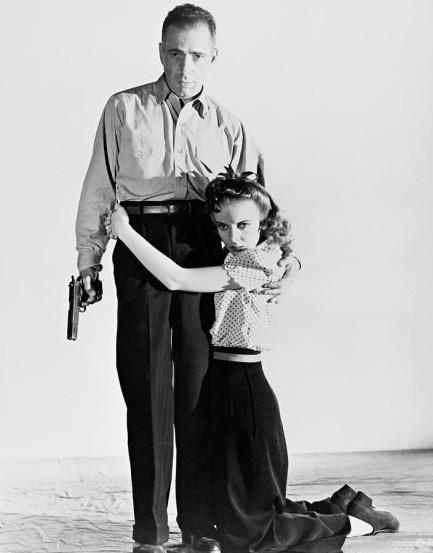 This one shows less domination and more protectiveness, as Humphrey Bogart prepares to defend Ida Lupino for High Sierra, 1941. This one shows less domination and more protectiveness, as Humphrey Bogart prepares to defend Ida Lupino for High Sierra, 1941.
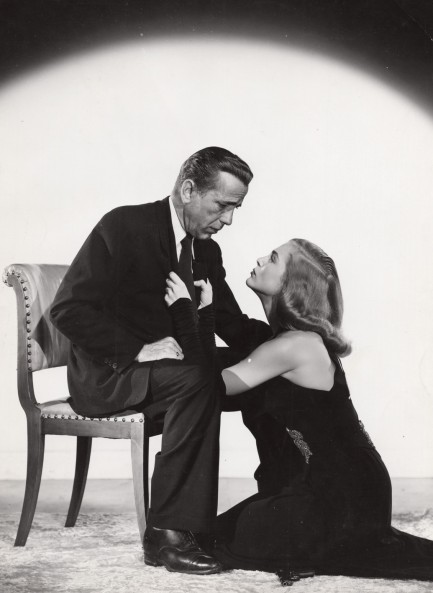 Humphrey once more. Here he's with Lizabeth Scott for Dead Reckoning, 1947. Humphrey once more. Here he's with Lizabeth Scott for Dead Reckoning, 1947.
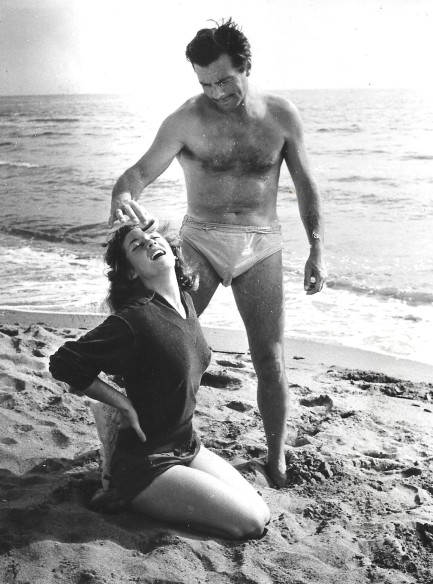 This shot shows Brazilian actress Fiorella Mari with an actor we can't identify in a movie we also can't identify. This shot shows Brazilian actress Fiorella Mari with an actor we can't identify in a movie we also can't identify.
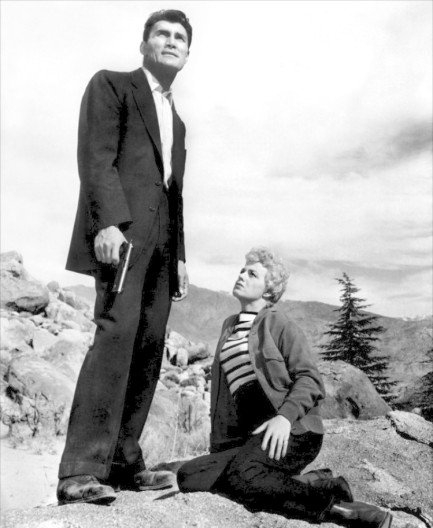 Shelly Winters and Jack Palance climb the highest mountain together for I Died a Thousand Times, 1955. Shelly Winters and Jack Palance climb the highest mountain together for I Died a Thousand Times, 1955.
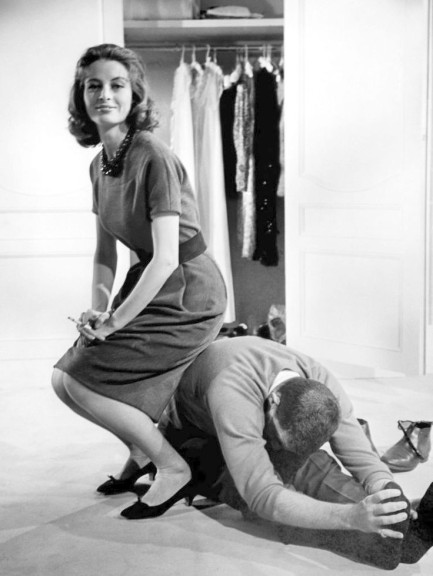 As we said, we didn't find as many examples of kneeling men, but we found this gem—Cappucine makes a seat of director Blake Edwards on the set of The Pink Panther in 1963. Does this count, though? While Edwards is subordinate, he isn't kneeling and it really isn’t a legit promo. As we said, we didn't find as many examples of kneeling men, but we found this gem—Cappucine makes a seat of director Blake Edwards on the set of The Pink Panther in 1963. Does this count, though? While Edwards is subordinate, he isn't kneeling and it really isn’t a legit promo.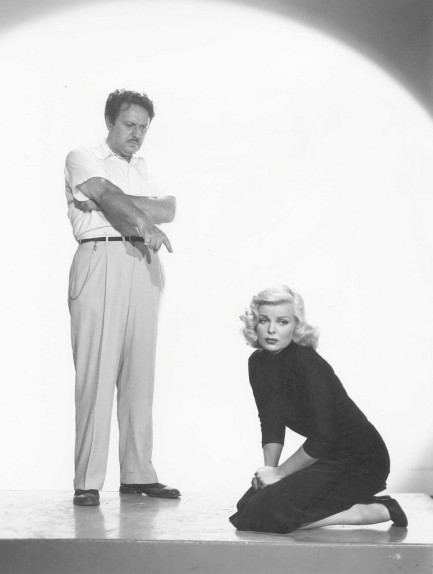 And lastly, in a curious example, Hugo Haas seems to tell Cleo Moore to stay in a shot made for 1953's One Girl's Confession. And lastly, in a curious example, Hugo Haas seems to tell Cleo Moore to stay in a shot made for 1953's One Girl's Confession.
 Seventy-five minutes of movie time never went so slowly. 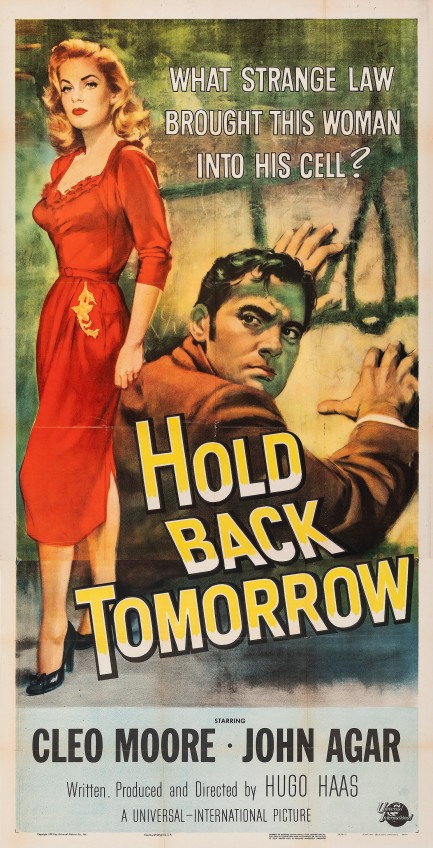
Above you see a poster for Hold Back Tomorrow, a movie written and directed by Hugo Haas, the man behind numerous low budget noirs, usually with Cleo Moore in a leading role. This effort is more of a melodrama than a film noir, but Haas and Moore dutifully collaborate once again, with Moore introduced to the audience when despondency over her descent into prostitution prompts her to jump off a bridge. Her suicide attempt is thwarted by a passerby and she returns to her lowly room, pretty much beaten by life. Next the audience meets the world's most annoying death row inmate John Agar, who, when promised a last wish by the warden, asks for several ridiculous things, most importantly a woman to keep him company. Just like that two prison officials go to the local dance hall, catch wind of Moore, ask her to keep Agar company, and conduct her, bedraggled and knackered from her near-death experience, to the penitentiary.
Most of the remainder of the film consists of Moore-the-suicidal and Agar-the-soon-to-be-executed getting to know each other in the cozy confines of his cell. Agar sums up the tedium of this with his hilarious line: “Shut up! I didn't ask for a psychiatrist. I asked for a girl!” Nevertheless, Moore keeps digging into that restive brain of his, and the two trade insights, debate finer existential points, talk of their pasts, fall in love, and get married by the prison priest before Agar is marched off to the death chamber for his just desserts. Oops—spoiler alert. The movie is exactly as cheesy as it sounds, and isn't a mandatory watch when there are scores of better period films from which to choose. Seriously—state authorities lock a suicidal woman in a cell with a convicted strangler? Come on. But don't take our word for it. Try it yourself and see if you feel like tomorrow can't come fast enough. Hold Back Tomorrow opened this month in 1955.
I wore my best dress. I hope this isn't too festive for death row. So I hear you're a strangler and dead man walking. That's fascinating. I'm a dancer and part-time hooker. My time in prison has taught me that strangling was always just a cry for help and a substitute for snuggling. Do you think we're in command of our own destinies, or do you think we were always meant to be in such a bad movie?
Screw destiny! I believe in free will and I'm outta here!
 They call it maximum security to scare you. I still get hair dye, cigarettes, good shoes, and pedicures, so I'm all good. 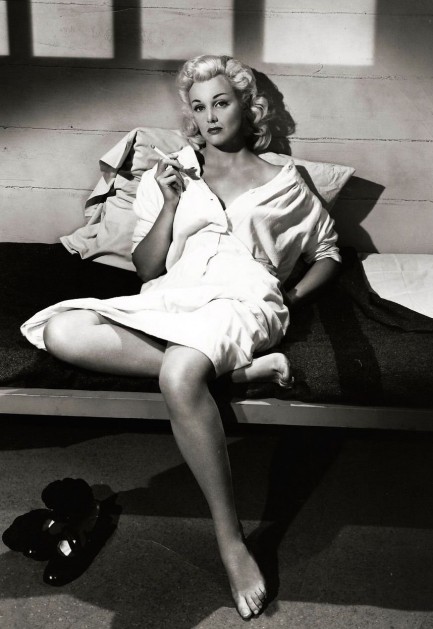
Let's circle back to Jan Sterling, shall we? As you know, she's become a favorite actress of ours, and since she has a number of excellent promo images we might as well run through a few. This one was made for her 1955 drama Women's Prison, in which her co-stars were Ida Lupino, Audrey Totter, and Cleo Moore. Think we'll be watching that? Well, with three great film noir icons in the cast, along with Sterling herself as one of the most elegant felons ever, you can bet on it.
 There's one suborned every minute. 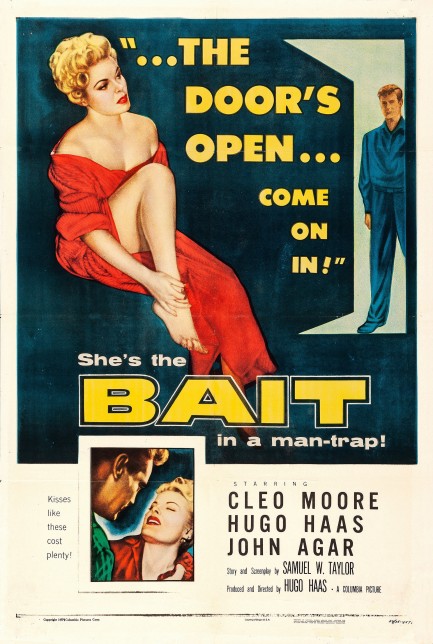
Above is a poster for Bait, which is a sort of a b-movie version of The Treasure of the Sierra Madre, but produced with half the budget and talent. Hugo Haas plays a man who made a gold strike two years ago, then got caught in a snowstorm, almost died, and hasn't had been able to locate the mine again. To accomplish this he takes on a partner played by John Agar. Meanwhile Cleo Moore plays a fallen townie woman Haas impulsively marries, and from that point onward the trio live together in a one-room mountain cabin. Haas has no intention of splitting the gold, and the close quarters lodging is all according to his master plan. It's unclear at first what that is, but we eventually find out: induce Agar and Moore into committing the then-crime of adultery so he can legally kill them. And you'll think: Isn't there an easier way not to share gold?
This flick is pure cheeseball stuff, with a cautionary introduction by the Devil himself (played by Cedric Hardwicke), and lots of sinister voiceover and greed sweats, but since it's one of seven collaborations between director/writer/star Haas and his muse Moore, for fans it's probably worth seeing. Objectively, however, though some of those collaborations managed to rise above their meager budgets and dubious scripts to result in entertaining films, this one doesn't. It's a bit like a bad high school play. Also, not a film noir, no matter what IMDB claims. The American Film Institute calls it a drama. Our recommendation: don't take the Bait. It premiered in the U.S. today in 1954. 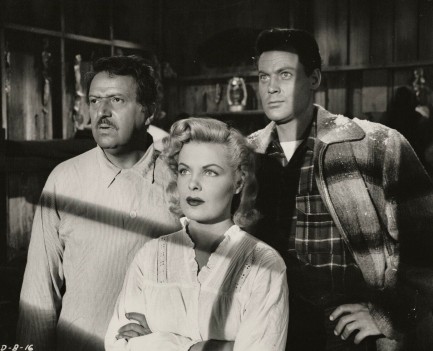 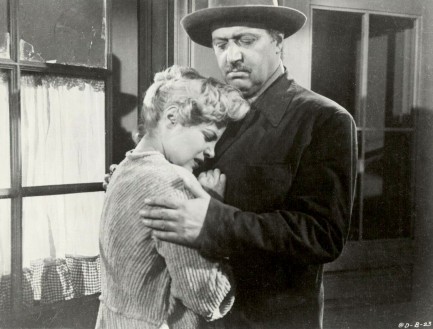 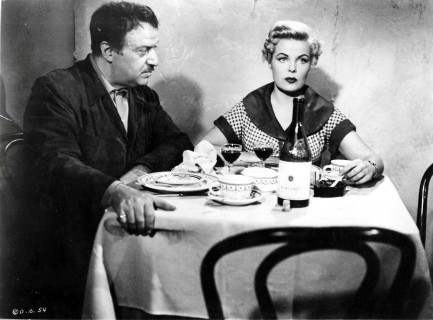 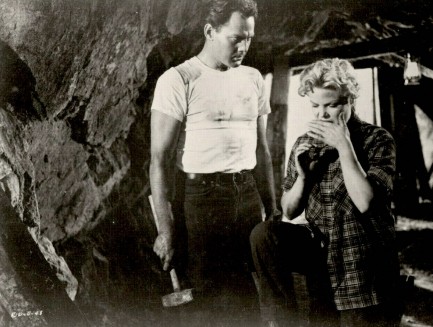 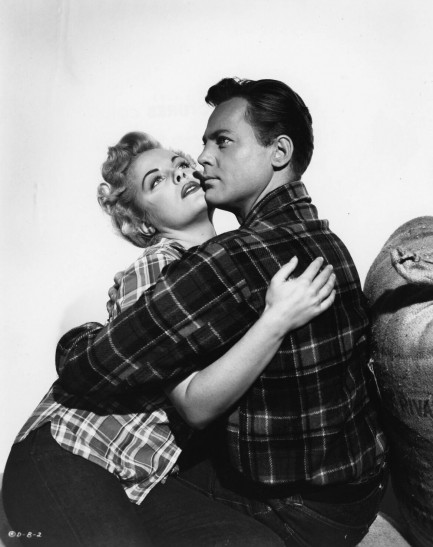 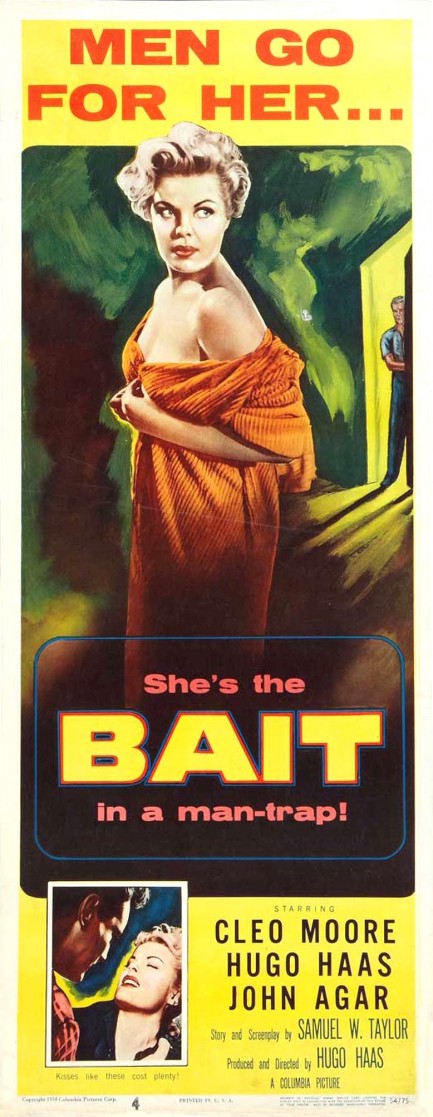
 What happens next could be great or terrible, depending on how well you distinguish subtle shades of color. 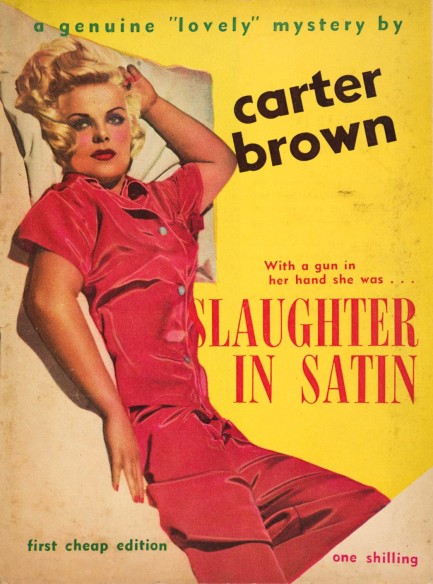
Since we just saw Cleo Moore why not bring her right back? Here she is on the front of Carter Brown's Slaughter in Satin, 1954, from the Australian publisher Horwitz. We've long documented this publisher's usage of minor celebrities on its covers, and pondered whether it was copyright infringement. What caught our eye about this example, besides Moore, was the typesetting. Notice how the “s” in the title disappears into Moore's red jammies, so at first glance it reads as, “Laughter in Satin,” which is almost an opposite outcome from slaughter, like the difference between being lain or slain. Probably when the book was first printed the two shades of red stood out from each other more. Or maybe this visual trick was intentional. Or maybe it was a miscalculation that couldn't be repaired. We'll never know. See the other Moore here, and see the celeb Horwitz covers by clicking here and scrolling.
 American femme fatale turns up down Rio way. 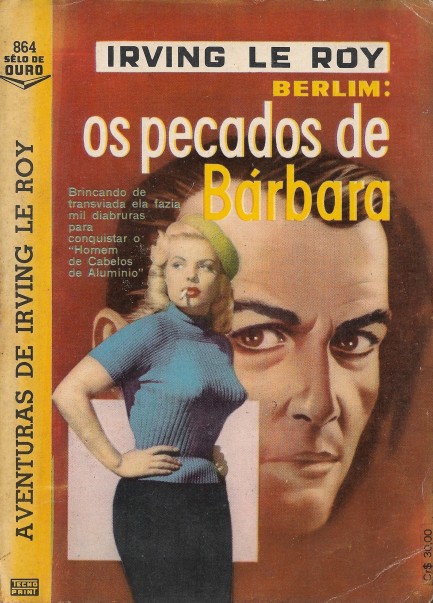
Okay, let's try this again. Last week we posted this book and thought it had Peggy Cummins on the cover, but after having a short nap we awoke and saw that this was clearly not Cummins. Thanks for the e-mails, by the way, but we beat you to it. Hah! Anyway, you know by now one of our favorite ways to highlight Hollywood actresses is to note their usage on foreign paperback covers. This cool example from Brazil's Edições de Ouro was made for Irving Le Roy's Berlim: Os Pecados de Bárbara, and that's none other than Cleo Moore—not Peggy Cummins—having a smoke and a look around. The image comes from her classic 1953 film noir One Girl's Confession, a movie we talked about a while ago. This book was first published in France as Aventure Est-Ouest by Éditions Fleuve Noir in 1956, so it represents a cross-pollination of a different type—we've seen material move from the U.S. to many countries, but from France to Brazil is a new one for us. Le Roy, by the way, was aka Robert Georges Debeurre, and we've shown you one of his books before, here. The above image came from the Brazilian Facebook page we pointed out not long ago.
 Moore than just another flash in the pan. 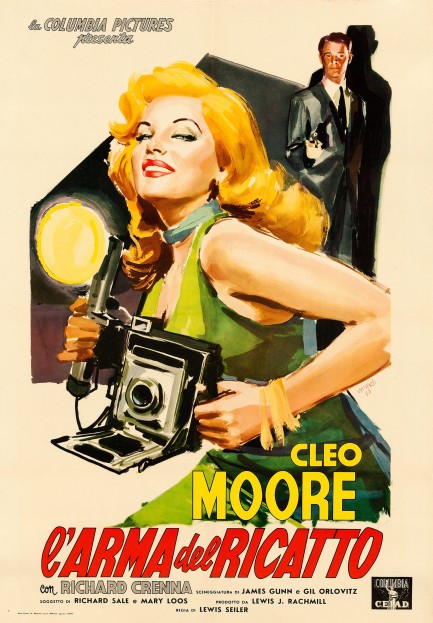
We've done a lot on b-movie femme fatale Cleo Moore. Above you see her getting a-level treatment on a stunning promo poster made in Italy for her 1956 hard luck drama Over-Exposed, which for its Italian run was called L'arma del ricatto, or “the weapon of blackmail.” This is a masterpiece. It was painted by Manfredo Acerbo, who also painted an iconic poster for Gilda we showed you a long while back. We've been neglectful in not digging up more from this guy. But we'll remedy that. There's no Italian release date for Over-Exposed, but it probably played there in mid-1957. You can read more about it here.
 Oh, you want Moore? Well I've got plenty. 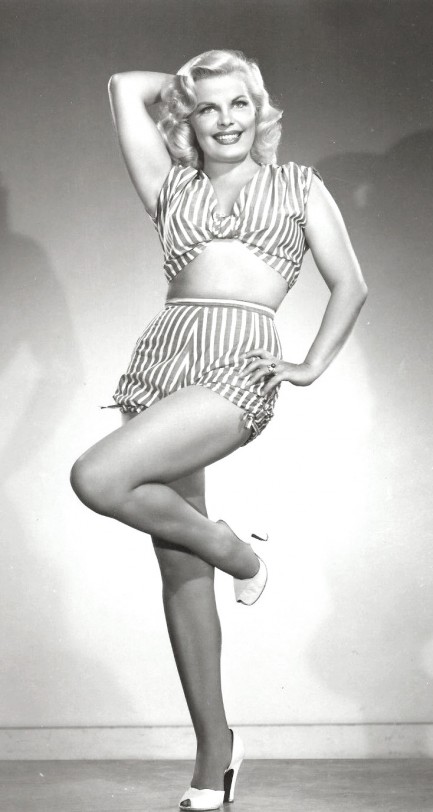 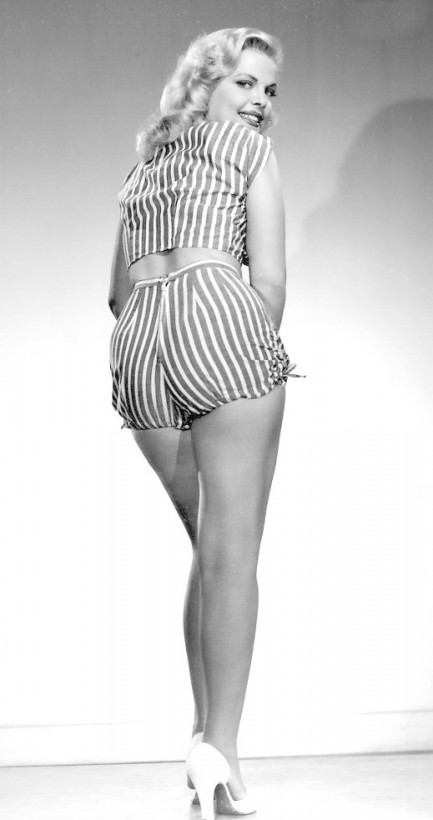
You often hear about how the 1950s was an era of “real” women. People who say this usually mean women had more normal body shapes—i.e. larger than today. As we've noted before, that was only partly true. Some of the biggest stars were Monroesque or Lorenesque (including Monroe and Loren, of course), but the trend also ran toward thinness. Think Hepburn and Linda Darnell. American actress and b-movie icon Cleo Moore, who you see in two nice shots above, was once rudely referred to as “well fed” by one publication. We can only imagine it annoyed the hell out of her. Something else that might have annoyed her is her real first name. Cleo was a shortened version of it. You're thinking Cleo something like patra, right? Well, she wasn't that lucky. It was Cleouna. Gee, thanks, mom and dad. See more Moore here and here.
 They say the truth will set you free, but it'll send her to prison. 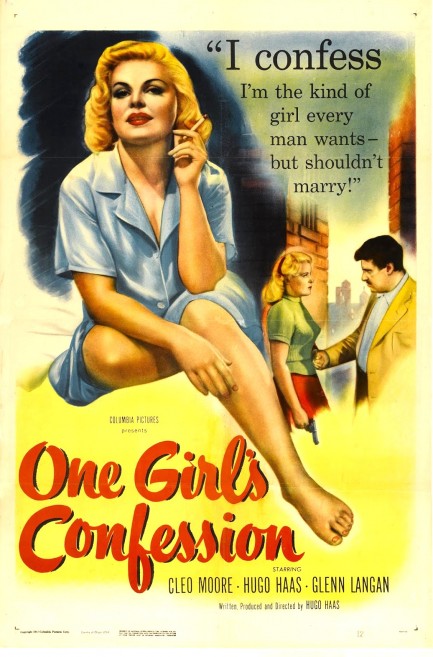
Written, directed, produced by, and co-starring Hugo Haas, One Girl's Confession is a morality play that ponders the role of fate in people's lives. Imagine a man leaving his house and stopping for a few moments to help a boy retrieve a ball. Ten minutes later a flower pot falls from a highrise balcony and crushes his skull. If he hadn't stopped to help the boy the pot would have missed him by ten feet. Terrible luck. But at his work that day there's a natural gas explosion, which would have killed him anyway.
That's the type of idea Haas plays with. He has Cleo Moore in the lead role as a woman who steals $25,000, wants to use the money to get ahead, but various metaphorical flower pots keep landing on her head. Maybe wealth just isn't in the cards. On the other hand, it's possible the fault, as they say, is not in her stars, but in her self. Helene Stanton plays a crucial support role, tipping the balance of fate at just the right moment, and Glenn Langan plays Moore's love interest.
One Girl's Confession is just a b-movie, but it manages to elevate itself above its ilk thanks to a charismatic lead performer. A seventy-four minute running time doesn't hurt either, as the curtain falls just before as central idea begins to wear thin. You probably have worse movies in your queue, so adding this one can't hurt. Maybe it'll help you avoid a flower pot. One Girl's Confession premiered in the U.S. today in 1953. 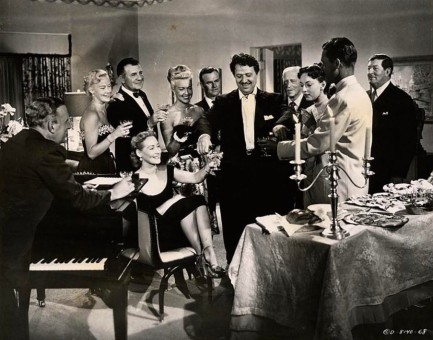 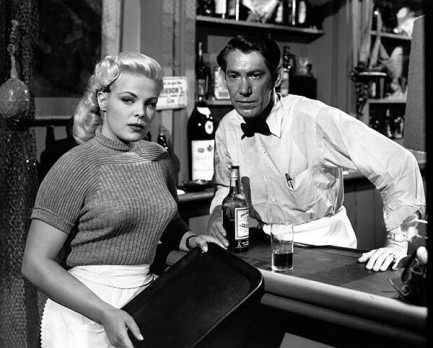 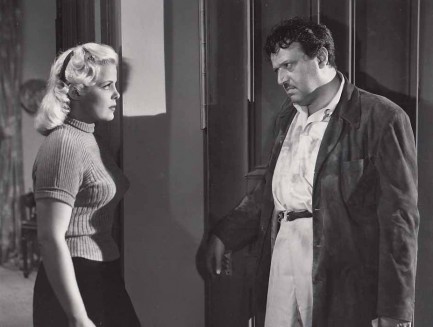 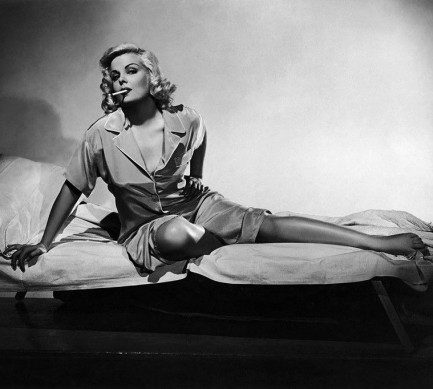 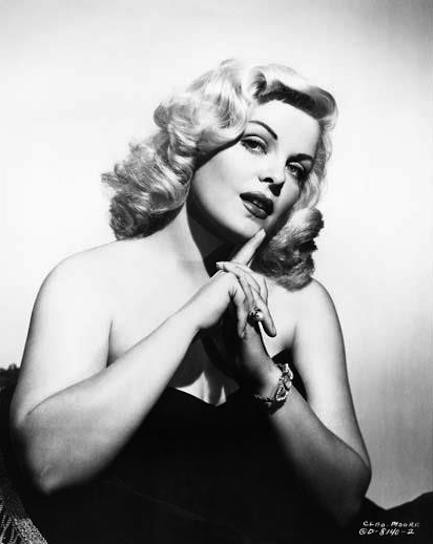 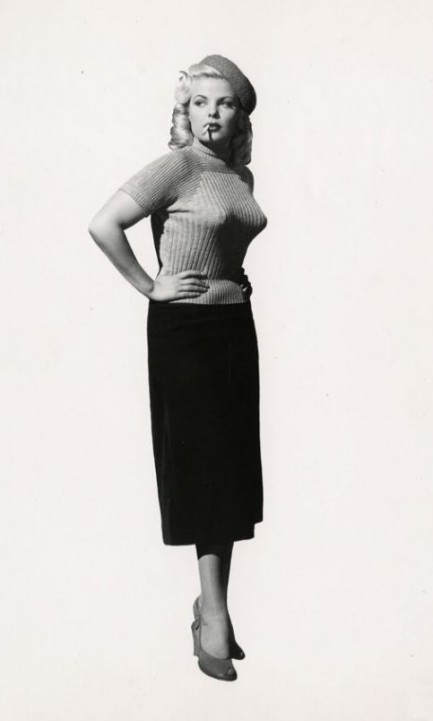 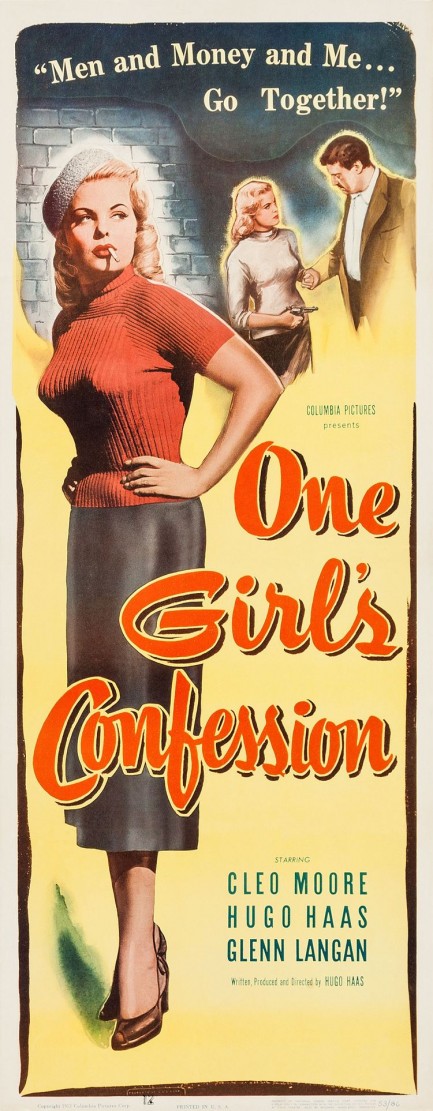
 There was a thirty chinchilla wrap, but I bought one made of twenty chinchillas. We all need to cut back to save the planet. 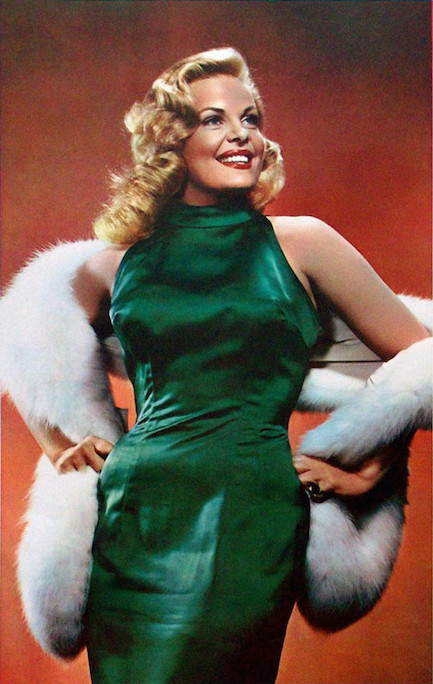
Above is a beautiful color promo photo starring b-movie femme fatale Cleo Moore looking like a Christmas wish come to life. The image was made for her 1956 crime drama Over-Exposed. We talked about it. Shorter version—clumsily moralistic but pretty fun. You can peruse our thoughts in more detail here, and see more Moore here.

|
 |

The headlines that mattered yesteryear.
2003—Hope Dies
Film legend Bob Hope dies of pneumonia two months after celebrating his 100th birthday. 1945—Churchill Given the Sack
In spite of admiring Winston Churchill as a great wartime leader, Britons elect
Clement Attlee the nation's new prime minister in a sweeping victory for the Labour Party over the Conservatives. 1952—Evita Peron Dies
Eva Duarte de Peron, aka Evita, wife of the president of the Argentine Republic, dies from cancer at age 33. Evita had brought the working classes into a position of political power never witnessed before, but was hated by the nation's powerful military class. She is lain to rest in Milan, Italy in a secret grave under a nun's name, but is eventually returned to Argentina for reburial beside her husband in 1974. 1943—Mussolini Calls It Quits
Italian dictator Benito Mussolini steps down as head of the armed forces and the government. It soon becomes clear that Il Duce did not relinquish power voluntarily, but was forced to resign after former Fascist colleagues turned against him. He is later installed by Germany as leader of the Italian Social Republic in the north of the country, but is killed by partisans in 1945.
|

|
|

It's easy. We have an uploader that makes it a snap. Use it to submit your art, text, header, and subhead. Your post can be funny, serious, or anything in between, as long as it's vintage pulp. You'll get a byline and experience the fleeting pride of free authorship. We'll edit your post for typos, but the rest is up to you. Click here to give us your best shot.

|
|




 Rod Taylor and Luciana Pauluzzi swap subordinate positions for 1967's Chuka.
Rod Taylor and Luciana Pauluzzi swap subordinate positions for 1967's Chuka. Edmund O'Brien goes for the time honored hair grab on Marla English for 1954's Shield for Murder.
Edmund O'Brien goes for the time honored hair grab on Marla English for 1954's Shield for Murder.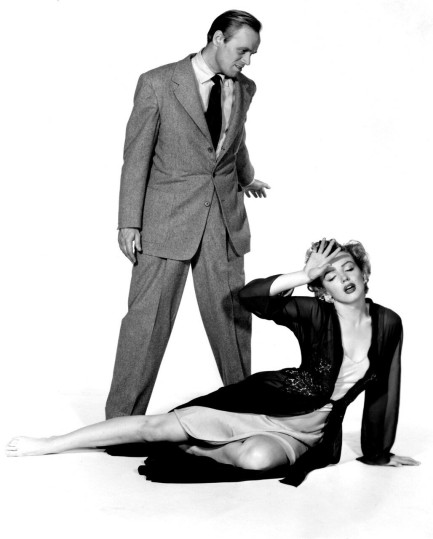 Marilyn Monroe swoons as Richard Widmark snarls for Don't Bother To Knock, 1952.
Marilyn Monroe swoons as Richard Widmark snarls for Don't Bother To Knock, 1952. Inger Stevens and Terry Ann Ross for Cry Terror, an adaptation of a novel we talked about a few years ago.
Inger Stevens and Terry Ann Ross for Cry Terror, an adaptation of a novel we talked about a few years ago. Kim Hunter soothes an overheated Marlon Brando in a promo for 1951's A Streetcar Named Desire.
Kim Hunter soothes an overheated Marlon Brando in a promo for 1951's A Streetcar Named Desire. George Raft menaces Marlene Dietrich in the 1941 comedy Manpower.
George Raft menaces Marlene Dietrich in the 1941 comedy Manpower.
 As promos go, these actually make sense. They show three unidentified models mesmerized by vampire Christopher Lee for 1970's Taste the Blood of Dracula.
As promos go, these actually make sense. They show three unidentified models mesmerized by vampire Christopher Lee for 1970's Taste the Blood of Dracula. Glenn Ford is at it again, this time looming over Rita Hayworth for the 1946 classic Gilda.
Glenn Ford is at it again, this time looming over Rita Hayworth for the 1946 classic Gilda. Aldo Ray and Barbara Nichols for 1958's The Naked and the Dead.
Aldo Ray and Barbara Nichols for 1958's The Naked and the Dead. This one shows less domination and more protectiveness, as Humphrey Bogart prepares to defend Ida Lupino for High Sierra, 1941.
This one shows less domination and more protectiveness, as Humphrey Bogart prepares to defend Ida Lupino for High Sierra, 1941. Humphrey once more. Here he's with Lizabeth Scott for Dead Reckoning, 1947.
Humphrey once more. Here he's with Lizabeth Scott for Dead Reckoning, 1947. This shot shows Brazilian actress Fiorella Mari with an actor we can't identify in a movie we also can't identify.
This shot shows Brazilian actress Fiorella Mari with an actor we can't identify in a movie we also can't identify. Shelly Winters and Jack Palance climb the highest mountain together for I Died a Thousand Times, 1955.
Shelly Winters and Jack Palance climb the highest mountain together for I Died a Thousand Times, 1955. As we said, we didn't find as many examples of kneeling men, but we found this gem—Cappucine makes a seat of director Blake Edwards on the set of The Pink Panther in 1963. Does this count, though? While Edwards is subordinate, he isn't kneeling and it really isn’t a legit promo.
As we said, we didn't find as many examples of kneeling men, but we found this gem—Cappucine makes a seat of director Blake Edwards on the set of The Pink Panther in 1963. Does this count, though? While Edwards is subordinate, he isn't kneeling and it really isn’t a legit promo. And lastly, in a curious example, Hugo Haas seems to tell Cleo Moore to stay in a shot made for 1953's One Girl's Confession.
And lastly, in a curious example, Hugo Haas seems to tell Cleo Moore to stay in a shot made for 1953's One Girl's Confession. 

